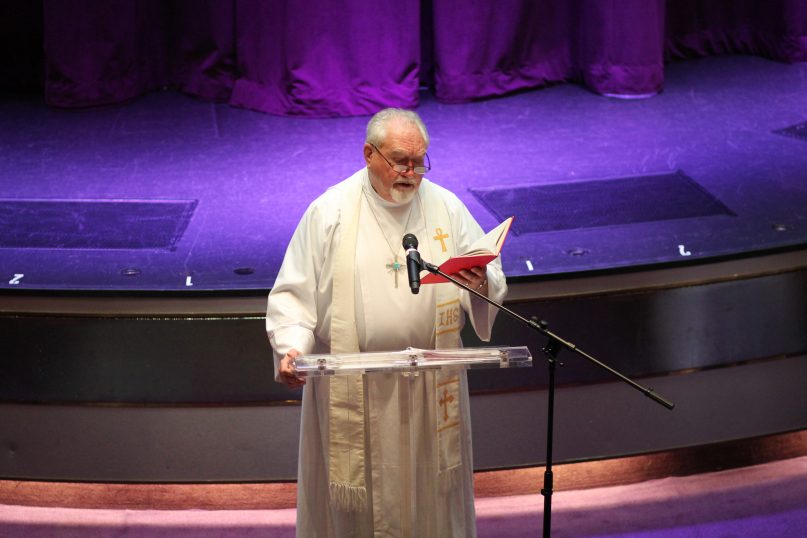When you pass the peace in a church service on a cruise ship, you don’t shake hands or hug each other. You bump elbows, so that you don’t transmit the Norwalk virus along with your warm welcome.
And when you celebrate a Sunday in Advent on a cruise ship, you note the fact of how many candles should be lit, but you don’t actually light them, because you can’t have an open flame on a cruise ship.
Those are things I learned on a two-week Holland America cruise to the Panama Canal. (Yes, it was wonderful. Please don’t hate me for saying that we missed almost all of the “bomb cyclone” that hit the Eastern U.S. shortly after we left. While the rest of you were suffering with subzero temps we were wearing shorts in Central America. I do feel somewhat guilty, if that helps.)
Since the cruise was over the Christmas holidays, we had a dedicated chaplain on board the whole time – the Rev. Donald B. Green of Pittsburgh, Pa. I got to sit down with him and find out more about his life.
My first question, of course, was “how does a person get this fantastic gig of being a chaplain on a cruise ship?”
There’s some stiff competition. Not surprisingly, a whole lot of people would like to serve as ministers, priests, and rabbis on cruise ships. They don’t get a salary, but they also don’t pay the full fare of the typical passenger, so it’s like a working vacation. Chaplains are charged a nominal fee for the privilege of being on board for the duration – perhaps $50 a day, though it varies — and they can bring a spouse or partner with them.
 By the time of our interview on Christmas morning, Rev. Green had already conducted a regular Sunday service, a midnight Christmas Eve service, and a short worship on Christmas Day. That may sound like a tiring schedule for a retired pastor, but he loves every minute of it.
By the time of our interview on Christmas morning, Rev. Green had already conducted a regular Sunday service, a midnight Christmas Eve service, and a short worship on Christmas Day. That may sound like a tiring schedule for a retired pastor, but he loves every minute of it.
“I just love doing cruise chaplaincy, being around people and talking one-on-one,” Green told me. He has a strong ecumenical bent and spent some of his career doing interfaith work in Pennsylvania, which is good practice for a cruise ship. Part of his job is to cater to the whole spectrum of Protestants – from Lutherans like himself to Episcopalians to evangelical Baptists.
He also participates in Jewish sabbath celebrations, and lends a hand if there isn’t a rabbi on board.
“One thing I’ve always made it a practice to do is to join the Jewish community on Friday night,” he says. He is just there to facilitate, not to lead; he also helps Jewish passengers balance their own religious diversity. “On a cruise like this you will have representatives from all four Jewish communities in America, and you also have Jews from different continents.”
Our cruise through the Panama Canal was Rev. Green’s eighth voyage as a cruise chaplain, and he’s visited a number of favorite ports that he might never have gotten to see otherwise. He was especially fascinated by China – the clouds of pollution, the freshly caught fish, the traffic. And he loved the Baltics and northern Europe, especially Estonia. The longest cruise he’s been on was 35 days, and he’s game for the adventure of even longer ones – perhaps one day circumnavigating South America (56 days) or the entire globe (113 days).
But it’s the people that he remembers most, and he goes out of his way to meet them. Whenever he comes on board a ship, he stops in the medical center to give the staff his cabin number and contact information so he can always be reached in case of an emergency. (On our cruise, sadly, someone passed away.)
He also wears his clerical collar frequently to signal his availability, which was also true at times for the Catholic priest on board our ship.
“Early on in the cruise I’ll wear my clerics quite a bit when I’m going to dinner, just so people will begin to recognize there’s a minister on board,” he says. “I’m here to do a job, and I want people to know that if they need me I’m here.”
He’s never performed a wedding at sea, but he has done some memorials. On one cruise, a World War II veteran who had lost comrades in the Sea of Japan asked if Rev. Green could officiate at a small memorial service when they were passing through that body of water. The ship provided a wreath, and they went to the top of the ship, said prayers, sang the navy hymn, and threw the wreath into the sea in honor of those who had died there. It was a very moving experience, he says.
He is also available to crew members. One memorable Easter, he officiated at a joyous midnight service for them – crew members on cruise ships often work until 11 p.m. — and served communion in the tiny plastic cups that are used for condiments at the buffet.
Rev. Green has found cruise chaplaincy work to be exceptionally satisfying and meaningful. “It gives me a chance to read, to meditate, and try to mirror the gospel of God’s mercy and acceptance to all sorts of people,” he says.
Next time, he might try to bring his grandson along too. Anchors aweigh.






